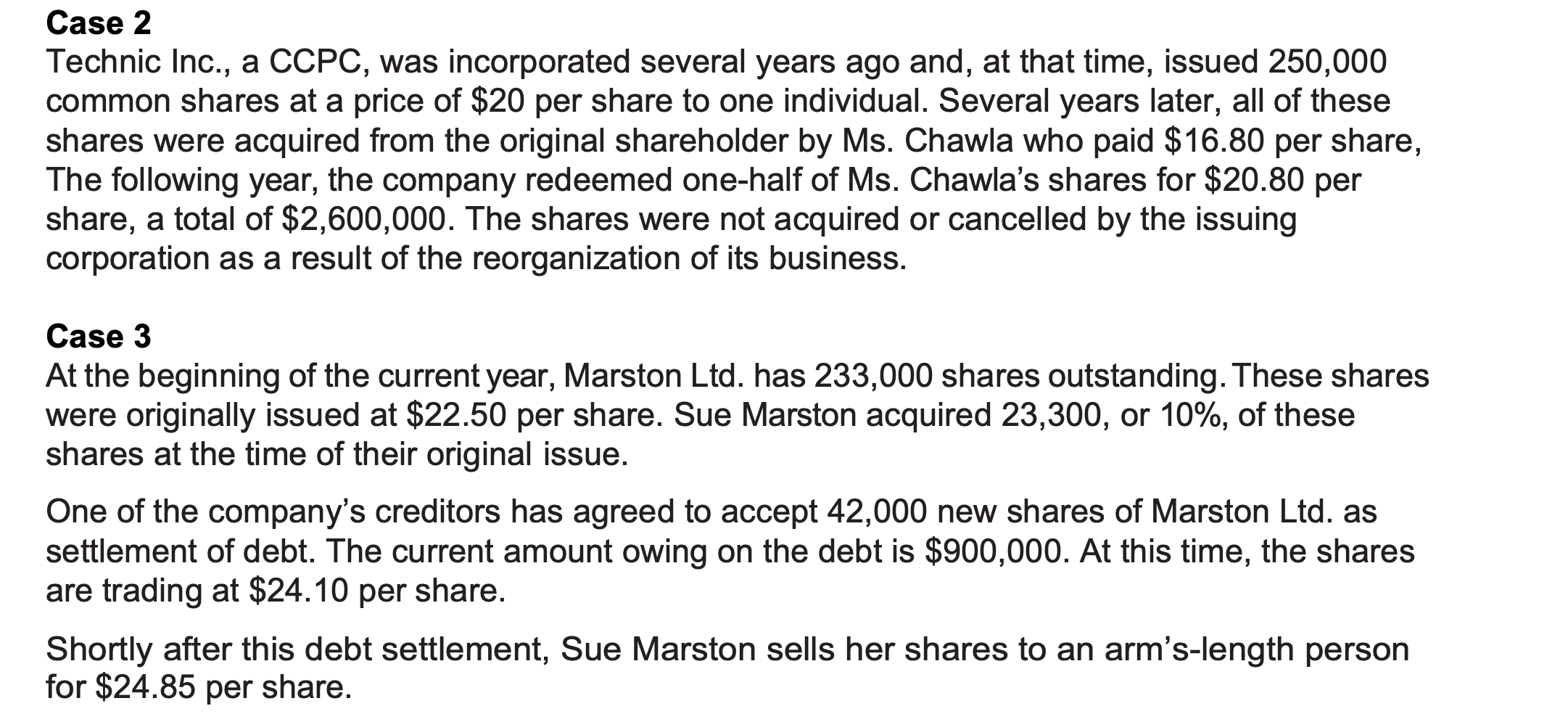


SSP 14-8 Corporate Surplus Distributions Required: Indicate the income tax consequences to the relevant shareholders of the transaction(s) described in each of the following four independent cases, including identifying the applicable IT 84 deemed dividend provision. Tax consequences include the increase or decrease in the individual shareholder's net and taxable income, any change in the ACB and PUC of any shares that are still outstanding after the described transaction(s), and any federal dividend tax credits. Assume that any dividends will be non-eligible. Case 1 John Farnsworth owns all of the outstanding shares of John's Jeans (JJ), a CCPC. His shares have a PUC of $323,000 and an adjusted cost base of $462,000. The board of directors agrees to make a corporate distribution that will include a reduction of legal capital and therefore PUC. The distribution is $260,000. The company reduced the PUC of its shares by $163,000 as a result of the distribution. This return of PUC does not relate to the reorganization of the company's business. 5 Case 2 Technic Inc., a CCPC, was incorporated several years ago and, at that time, issued 250,000 common shares at a price of $20 per share to one individual. Several years later, all of these shares were acquired from the original shareholder by Ms. Chawla who paid $16.80 per share, The following year, the company redeemed one-half of Ms. Chawla's shares for $20.80 per share, a total of $2,600,000. The shares were not acquired or cancelled by the issuing corporation as a result of the reorganization of its business. Case 3 At the beginning of the current year, Marston Ltd. has 233,000 shares outstanding. These shares were originally issued at $22.50 per share. Sue Marston acquired 23,300, or 10%, of these shares at the time of their original issue. One of the company's creditors has agreed to accept 42,000 new shares of Marston Ltd. as settlement of debt. The current amount owing on the debt is $900,000. At this time, the shares are trading at $24.10 per share. Shortly after this debt settlement, Sue Marston sells her shares to an arm's-length person for $24.85 per share. 3 Case 4 After liquidating one of its divisions a corporation has additional cash of $1,175,000, all of which is distributed to the corporation's only shareholder. The sole shareholder has owned the only class of authorized shares for more than five years. The distribution will result in 40% of the shares being cancelled. The PUC of the class of shares is $800,000 and the total ACB is $1,450,000. The balance in the company's capital dividend account is $1,000,000, and the company makes the appropriate election to have the deemed dividend on the distribution treated as a capital dividend under ITA 83(2) SSP 14-8 Corporate Surplus Distributions Required: Indicate the income tax consequences to the relevant shareholders of the transaction(s) described in each of the following four independent cases, including identifying the applicable IT 84 deemed dividend provision. Tax consequences include the increase or decrease in the individual shareholder's net and taxable income, any change in the ACB and PUC of any shares that are still outstanding after the described transaction(s), and any federal dividend tax credits. Assume that any dividends will be non-eligible. Case 1 John Farnsworth owns all of the outstanding shares of John's Jeans (JJ), a CCPC. His shares have a PUC of $323,000 and an adjusted cost base of $462,000. The board of directors agrees to make a corporate distribution that will include a reduction of legal capital and therefore PUC. The distribution is $260,000. The company reduced the PUC of its shares by $163,000 as a result of the distribution. This return of PUC does not relate to the reorganization of the company's business. 5 Case 2 Technic Inc., a CCPC, was incorporated several years ago and, at that time, issued 250,000 common shares at a price of $20 per share to one individual. Several years later, all of these shares were acquired from the original shareholder by Ms. Chawla who paid $16.80 per share, The following year, the company redeemed one-half of Ms. Chawla's shares for $20.80 per share, a total of $2,600,000. The shares were not acquired or cancelled by the issuing corporation as a result of the reorganization of its business. Case 3 At the beginning of the current year, Marston Ltd. has 233,000 shares outstanding. These shares were originally issued at $22.50 per share. Sue Marston acquired 23,300, or 10%, of these shares at the time of their original issue. One of the company's creditors has agreed to accept 42,000 new shares of Marston Ltd. as settlement of debt. The current amount owing on the debt is $900,000. At this time, the shares are trading at $24.10 per share. Shortly after this debt settlement, Sue Marston sells her shares to an arm's-length person for $24.85 per share. 3 Case 4 After liquidating one of its divisions a corporation has additional cash of $1,175,000, all of which is distributed to the corporation's only shareholder. The sole shareholder has owned the only class of authorized shares for more than five years. The distribution will result in 40% of the shares being cancelled. The PUC of the class of shares is $800,000 and the total ACB is $1,450,000. The balance in the company's capital dividend account is $1,000,000, and the company makes the appropriate election to have the deemed dividend on the distribution treated as a capital dividend under ITA 83(2)









